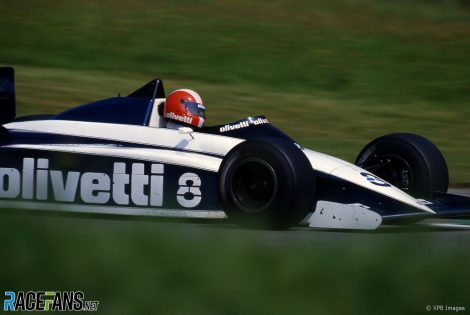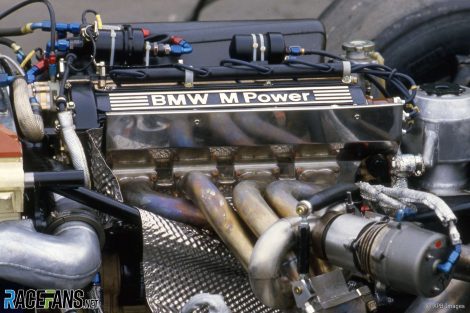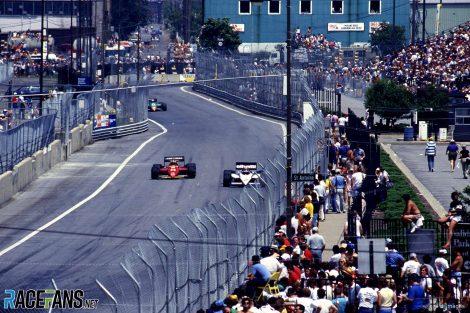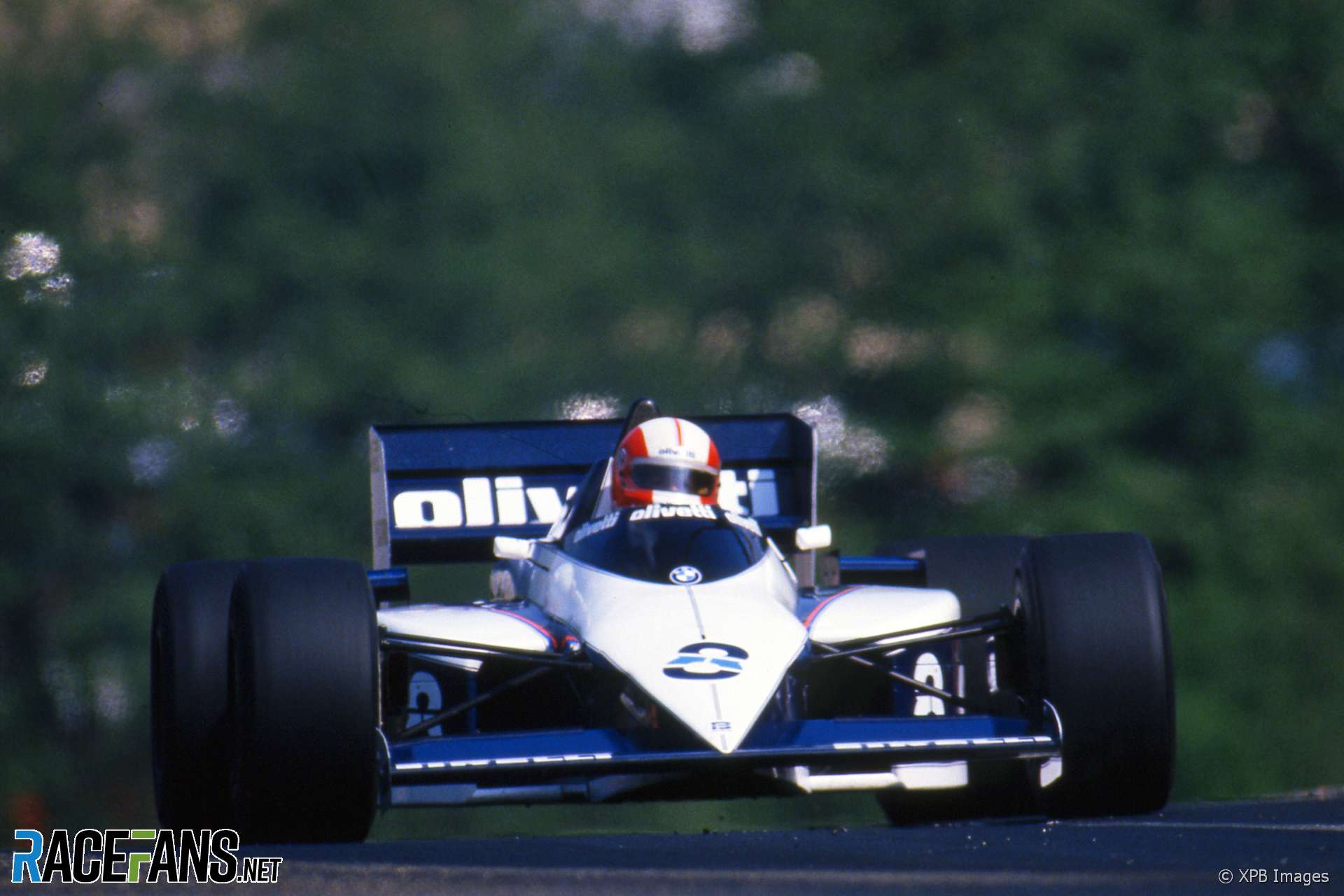The current generation of Formula 1 cars are incredible machines.
They are faster around a lap than anything else the sport has ever seen. Their sophisticated turbo hybrids operate at a level of efficiency beyond ordinary road cars.But in terms of pure brute power, today’s F1 engines remain in the shadow of the outrageous machines which prowled the world’s Formula 1 track three-and-a-half decades ago.
The technology at the time of F1’s ‘turbo era’ was positively prehistoric compared to today. And engineers were bound far more loosely by the regulations and restrictions on spending were practically unheard of. This made for spectacular results.
A telling comparison between then and now can be seen in the teams’ approach to qualifying. While engines needed to be tuned down for races to improve reliability, their full power of the turbo engines could be unleashed for a single qualifying lap qualifying, just as today’s 1.6-litre V6 hybrid turbos are.
Today power units are built to last at least seven races, and special performance modes are activated for qualifying runs. But 35 years ago, for manufacturer-backed teams with money and hardware to burn, qualifying meant fitting an engine for just one lap of total power with explosive results – often literally.

“A Formula 1 engine without a turbo had 150 horsepower,” he explained. “Like a stock from a road car, it was 1.5 litres. This was a small engine with no power.”
The turbo boosted that output to around 850bhp in race trim. Its power delivery curve was more like a vertical line – “nothing or all”, as Surer put it.
Advert | Become a RaceFans supporter and

“When you go into the corner, you go off the brakes and full on the throttle, going into the corner, to build up the [turbo] pressure,” Surer explained. “And then going out of the corner suddenly the power wants to come.
“In this moment you have to go back otherwise you spin. You back off the throttle because suddenly you had too much power. So it was a very strange driving style.
“Of course you finally adapt to it. But I think the most difficult car to drive was the turbo from BMW.” Unsurprisingly, he described trying to do the same in wet conditions as a “disaster”.
If this sounds hard enough in race trim, for qualifying runs the engine would be “turned up to the limit” of maximum performance. It could withstand this treatment for a single lap – at most – “and then the engine was dead.”
Advert | Become a RaceFans supporter and
“If you had to abandon the lap you could not do another one,” said Surer. “The engine was gone. They throw the engine away after that.
“For qualifying you lined up the last time out to qualify at maximum – I think it was six-bar – boost.”

Fully unleashed, the engine produced levels of power that the chassis of the time struggled to contain.
“With the full power you have wheel spin up to fourth gear,” grinned Surer. “And then in fifth and sixth you started to go. And then the straight was finished! So you always wanted longer straights.
“It was an impressive feeling. I’m sure it is like you sit on a rocket going to the moon, it must be the same feeling. On the straight it was going like hell. And it was the moment that you put fifth gear when you finally could floor all the power and was accelerating… this experience was unbelievable.”
Marc Surer was speaking to RaceFans for an upcoming edition of My F1 Cars. Don’t miss the full-length feature coming soon.
Video: Karun Chandhok’s F1 cars
Last week’s guest for My F1 Cars was Karun Chandhok. Watch an extended version of RaceFans’ interview with much more insight from him on our YouTube channel:
Become a RaceFans Supporter
My F1 Cars is part of a new series of articles we are running throughout the hiatus. To help RaceFans produce more great original articles – and to browse the site ad-free – please consider becoming a RaceFans Supporter.
Find out more and sign up here:
Go ad-free for just £1 per month
>> Find out more and sign up
F1 history
- How you rated F1’s 12 sprint races so far – and why two outscored the grand prix
- Alonso set to become F1’s oldest driver for more than 50 years
- From ‘Flying Pig’ to Senna’s heroics: The short, incredible history of Toleman
- From farcical to fantastic: Formula 1’s 14 title-deciding Japanese races ranked
- Benched: The five other drivers who stood down for team mates in last 50 years
Don't miss anything new from RaceFans
Follow RaceFans on social media:





Sensord4notbeingafanboi (@peartree)
14th April 2020, 8:26
Don’t let Greta read this article.
Phylyp (@phylyp)
14th April 2020, 8:38
@peartree – what do you mean? F1 is awesome – we’ve gone zero carbon emissions in 2020 itself! ;)
Ram
14th April 2020, 8:48
She would probably point to the Zero miles per gallon rating. :)
MEGATRON M12 (@megatron)
14th April 2020, 9:34
The current cars are also purported to be able to spin the tires in 4th gear as well.
Turbos were clearly the dominant technology since the early 80s, and F1 was foolish to ban them. Should have just mandated road fuel, continued to lower the fuel allotment and banned the qually engines.
The current PUs are the most incredible powerplants in F1 history.
JC Case (@jccase)
14th April 2020, 10:26
Just think if they had not banned these engines and the development of those and the turbo-engines for passenger cars would have continued too for +30 years. I would guesstimate that you would he able to buy a car with a 0.3 l turbo engine in it with +200 bhp, that it wouldn’t use more than 0.3 litre of petrol per 10 km (0.6 miles)
Not to mention if you just wanted a small car to to commute with, with let´s say with turbo engine at 0.2 L capacity and with “only” 100 bhp. It would be light and on top of that a have very low fuel consumption too.
In hindsight, banning the turbo-engines in F1 more than 30 years was one of the biggest mistakes made if you look the environment problems of today, (although I know why they did it). And pretty much no-one had much concern about the environment and the global warming in those days.
Kasim
14th April 2020, 11:45
Good point!
erikje
14th April 2020, 11:51
More air, means more fuel.ice engines are very inefficient and that developing route would end soon.
BasCB (@bascb)
14th April 2020, 12:24
I don’t think that is quite what would have happened @jccase. Turbo engines were used in both sportscars as well as rallye cars (and indy cars) when they were no longer used in F1.
Sure, F1 would have pushed development of Turbos, but turbos have also been developed further in many other uses, for example there is no truck (or bus) younger than 30 years that does not have a turbo on their engines. Not to mention Diesel powered cars that until quite recently made up to 40% of sales (and up to 60% of sales in many countries), as well as a large amount of the small engines used in petrol cars in Europe for example.
JC Case (@jccase)
14th April 2020, 20:23
Many of you seems to missed my whole point.
If the turbo engines had been developed for +30 years in both F1 and bý the car manufacturers too, so would both of them have reached a point when they would had realized that they needed to reduce their engines fuel consumption, regardless if they were used in F1 or for personal transportation, without a single doubt.
But once they got removed from F1, it took the “air” out of the Turbo magic. I mean, pretty much every product on the market was called Turbo during the late 80´s. Everything from watches to hair dryers and even alcoholic beverages, and the list goes on.
Hence why I say that it in hindsight was a mistake to ban the turbo-engines in F1 for +30 years ago, as had the development of the petrol turbo engines continued both in F1 and by the car manufacturer’s, I´m certain that we would have such cars available today.
And as an old truck-driver I know that you get more “bang for the buck” if you use a turbo-diesel engine than a normally aspirated one. And it’s of course because they can pull heavy loads at a lesser price, ie lesser fuel consumption which is of great importance for the owners of those vehicles and the environment too btw.
Dave
14th April 2020, 12:24
The current fuel flow limit annoys me for similar reasons. Limit the total fuel for a race, then let teams choose how to use it. If they can build an engine which is very economical when desired, and has ridiculous peak power output, that’s practically the holy grail for road cars.
Dave
14th April 2020, 12:39
Btw, extrapolating from old race engines, we ought to be driving 100cc 2-strokes by now:
https://advrider.com/f/threads/380-bhp-liter-40-years-ago.412922/
Keith Collantine (@keithcollantine)
14th April 2020, 15:45
Part of the reason they don’t do that is to avoid large discrepancies in top speed between cars and sudden changes in speed as drivers switch between modes.
anon
14th April 2020, 13:08
@jccase no, such developments would not be remotely possible for passenger cars.
Firstly, as noted in the article, those power outputs couldn’t be sustained for extended periods of time – the boost pressures used in qualifying for some of those engines, such as the M12, would cause significant damage to them.
Those turbo engines were notoriously inefficient, quite often relying on having quite fuel rich air-fuel mixtures to cool components via evaporative cooling (we’re talking about fuel consumption rates that are closer to 2-3mpg).
In reality, if you look at the (much lower) maximum theoretical power output in race trim, it was impossible for team to sustain that for a full race distance – with the progressive reductions in fuel tank size, it’s fairly obvious that if teams were using over 300 litres per race in earlier years when refuelling was allowed, they weren’t going to be running at full pelt when the fuel allowance was cut significantly below that (starting at 240 litres, then 220, 195 and eventually 150 litres).
There is also the problem that the fuel being used, which for most teams was based on toluene, is also highly toxic and long term exposure can cause permanent neurological damage – that is why the sport banned using toluene decades ago now.
As for Rosche’s supposed claim that the engines produced 1,400bhp – well, no offence, but Rosche had a habit of making up a lot of garbage in later years for the English speaking world that is demonstrably false (and he didn’t repeat most of those claims in the German press, it is worth noting). For example, the stories he made up about the types of fuel that they were supposedly using are complete and utter nonsense, and indeed it seems there is more myth than fact being put out about the M12 these days.
Dave
14th April 2020, 15:05
I still think anon stands for Adrian Newey’s Online Name. :)
Phylyp (@phylyp)
14th April 2020, 16:12
Best explanation I’ve seen on why anon doesn’t want to sign up :)
socksolid (@socksolid)
14th April 2020, 16:46
He is more like someone who goes out of his way to never do any research for his claims or post sources.
anon
14th April 2020, 18:00
@socksolid on the contrary, I have spoken with former industrial chemists who worked for some of the fuel suppliers who were active in that period, obtained dyno charts for some of the engines of that period and also obtained technical papers written by figures who were active at the time.
What effort have you put in to obtain primary sources of information from contemporary sources?
GnosticBrian (@gnosticbrian)
14th April 2020, 20:01
Anon – Toluene, I remember the literally ‘eye watering’ exhaust and the powerful smell when standing at Becketts, Nasty stuff indeed. That and the thunderous bang from Keke’s FW10 on the charge up to Druids.
Glenn (@glennb)
15th April 2020, 15:46
I spent a lifetime working in the aircraft overhaul/repair industry. A particular aircraft called a HS748 (Hawker Siddeley) had rubber de-icer boots on the mainplane leading edges. We had to remove and replace them several times per lifetime. They were bonded on with rubber adhesive to the aluminium substrate. We would remove the entire leading edge from the aircraft, wrap it in heavy plastic and pour maybe 40 litres of Toluene into the “bag”. Leave overnight in the hangar and scrape and wrestle it off it in the morning. I can vouch that the fumes from this caused everyone headaches and nausea. I dont think I suffered any brain damage but have definitely suffered from respiratory issues since. I also used to use the Toluene in a high compression 2 stroke, 370cc motorcross bike to reduce pinging. It was a common thing to do back then.
Trichloroethylene was another nasty product we used in the industry but that’s another story altogether.
Kasim
14th April 2020, 11:44
Amazing. What a thrill it must have been driving those brutes.
Surely it was more fun also to watch the drivers tustle with the new more powerful and torquey engines in 2014. The engineers quickly put an end that though unfortunately..
If would be a dream to have better tyres suited for proper racing, cheaper engines but higher power and torque, higher revving, 2014 downforce levels, same width tyres and a limit on engineering ability to sterilise the brute force of the cars.
Just a dream lol.
Oh and enforced shorter wheelbase.
Steev
14th April 2020, 14:41
3 times World Drivers Champion Piquet once described the rush of power of this mighty engine was like walking blindfolded off of a ten story building. The power was fantastic.
obster
14th April 2020, 16:07
Saw this car in action at the rescheduled 1985 Spa GP. Coming down the hill to Pouhon it left black tire marks from its acceleration.
Amazing.
Phylyp (@phylyp)
14th April 2020, 18:15
The sheer excess and profligate waste is astounding. And it gives me a visceral thrill just reading it (and a feeling of sadness that I wasn’t following F1 in that era).
anon
14th April 2020, 21:28
@phylyp to some extent, BMW was the most extreme example in that field – even amongst the manufacturers, who could afford to produce larger numbers of engines, BMW was unusual in being prepared to spend that much money on burning through as many engines as it did per season.
By way of comparison, the TAG-Porsche partnership produced a comparatively small number of engines. By the end of 1984, Porsche had produced a grand total of 15 TTE P01 engines – which includes at least one being used in a Porsche 956, which had been converted into a rolling test bed, and engines which were being used by McLaren for private tests as well. By the end of 1986, McLaren are recorded as having paid for 30 engines up to that point in their partnership – several of their engines are recorded as having been used for two or three races back to back, because they weren’t just throwing them away in the manner that BMW was.
The Cosworth GBA is another example – the early engines that were used did have a number of flaws, in part because Duckworth was comparatively less experienced with turbocharged engines and did go off in a flawed direction when he tried to build an F1 engine based on the BD series engine. However, by 1987, that engine was reportedly pretty solid – when run in race trim, Geoff Goddard quoted a rebuild interval of 1000km, or about three race distances.
If you look to the independent engine manufacturers, I believe only Motori Moderni produced bespoke qualifying engines, although those were intended to be used for a couple of sessions rather than just a lap or two. You also have the likes of Hart – their peak engine manufacturing capacity was 12 a year, and that includes customer supplies to third party teams as well as to Toleman (their primary partner).
Even for a major manufacturer, building an F1 engine at the time wasn’t cheap – there is a reason why there is the (potentially apocryphal) quote about F1 being “the sport of corporations” arising at that time – and not that many thought that it made financial sense, or for that matter technical sense, to throw away engines at that high a rate (because, after all, if you blow an engine to bits, you’ve got a lot less to work with if you’re trying to then improve the performance of that engine).
mfreire
15th April 2020, 13:35
What’s really amazing about those BMW engines was that they were based on a production block, and in qualifying at the top of the rev range the turbos were producing 5.5 bar (!!!!) of boost- hence why they could produce 1,400 hp. But those BMW engines were also some of the least reliable engines of that time- in 1982 and 1984 they failed so consistently in Piquet’s car he had no chance of defending his championships from the two respective previous years. It might have something to do with the fact that it was a single turbo engine as opposed to the V6 and V8 turbo cars, which were all twin-turbo cars.
Tifoso1989 (@tifoso1989)
15th April 2020, 13:53
anon,
Do you have any idea about the other manufacturers ? I remember watching an old video of Jackie Stewart which was about Lotus JPS preparations for race weekends. He showed that Renault were indeed using two engines, one for qualy and the other for the race and difference lies in the turbo used in both engines. He explained that the qualy engine would last 2/3 laps and would actually die after that.
mfreire
16th April 2020, 15:05
That’s probably what all the engine manufacturers did except for Porsche, who made something like 30 engines throughout their 4 1/4 year partnership with McLaren. With the amount of boost they were running in qualifying the stress put upon those qualy engines and the rest of the drivetrain would often mean they just could not last the race distance. Those qualy engines were called “grenades” in those days because they would so often blow up during a qualy lap.
Ipsom
14th April 2020, 19:04
Amazing how these 80s cars seem to increase in hp… remember reading full boost was 1000, then 1200, now 1400! Wow
mfreire
15th April 2020, 3:09
I would like to see how today’s cars would perform with unrestricted boost. I wonder if that’s possible (they would have to increase the amount of engines allowed every year)?